#musa ibn nusayr
Text
As I promised, let's start with the bookscans:
Al-ANDALUS. PERSONAJES HISTÓRICOS
(Al Andalus. Historical figures)
Concepción Masiá
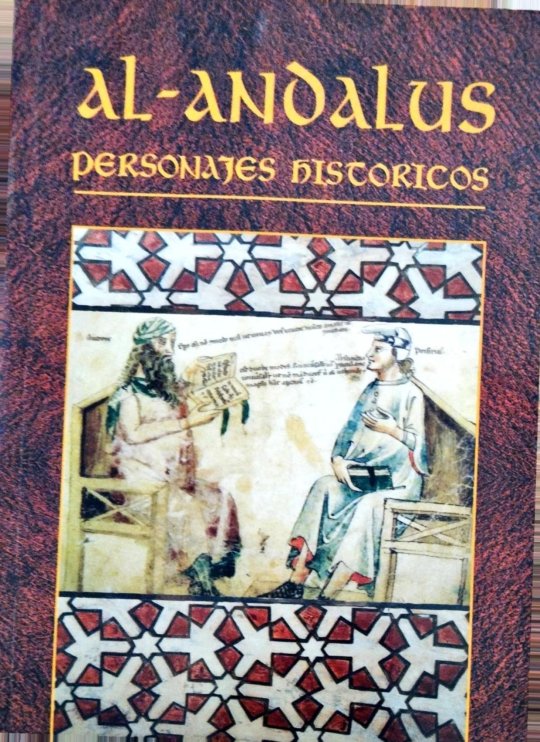
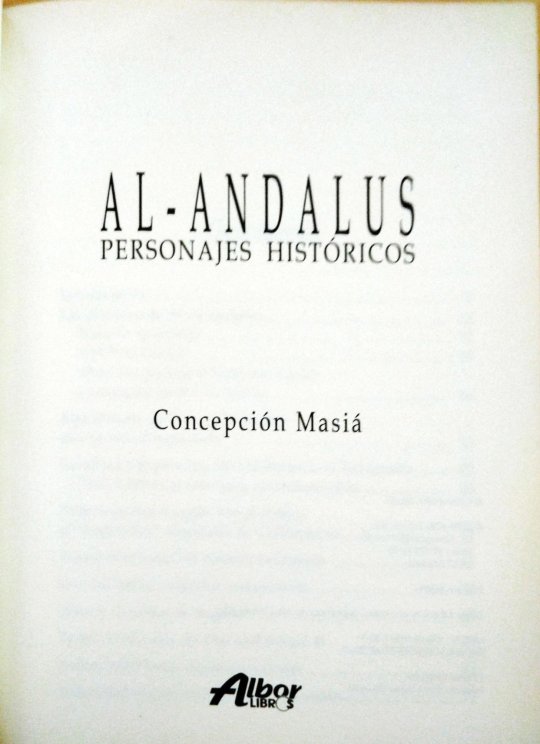

Summary
Introduction.................................. 9
The precursors of al-Andalus.....13
Count Don Julián....................13
Tarif ben Malluk. ....................15
Musa ben Nusayr and Tariq ben Ziyad: the conquerors of Spania...........16
Abd al-Aziz: a good governor with an unfortunate fate ..........................25
The Odyssey of Prince Abd al-Rahman the Immigrant......................................29
Abd al-Rahman was only twenty-five years old.........................................36
Sulayman ben Yaqzan ben al-Arabi: Charlemagne's deceived "deceiver" ........................... ...........41
Amrus ben Yusuf: the muladí of Huesca
.............................................................47
The “rabadies”: adventurous spirits.. ..............................................53
Ziryab: the singer of Baghdad........61
Tarub: the favorite of Abd al-Rahman II...............,...........................................67
Abbas ben Firnas: the first aviator............................ ......................73
Yahya ben Hakan al-Bakri: the miserly poet.....................................................77

Abd al Chabbar and Sulayman ben Martin: the rebels of Mérida..........................81
Eulogio and Álvaro de Córdoba:
pursuing martyrdom..........................85
The Andalusian Vikings..................... 95
The emir Abd Allah distrust and death...............................….................... 101
Musa ben Musa ben Qasi: the third king of Spain.......................................................107
Ibn Hafsun: the unredeemed rebel.....115
Abu Alí al-Sarrach: the Andalusian missionary. ...........................................125
Ibn Masarra: a freethinker in Spanish Islam.......,...........,...................................131
Abd al-Rahman III:
the first independent caliph of al-Andalus. ...........,................................137
Hasday ibn Shaprut:
the Jewish doctor of Abd al-Rahman III............ ....... ...................... ................... 145
Andalusians in France: the “Moorish kingdom” of Fraxinetum....................... 151
Rabbi ben Zayd: Bishop Recemundo............................................. 157
Al-Hakam al-Mustansir bi-llah:
passion for culture.................................. 161
Ibn Abd Rabbhi, the encyclopedist,
and Ibn Futais, the collector.................. 167
Al-Mansur “the Victorious” ...................171
Hisham II and Sanchuelo: misrule. .......191
Abu Muhammad Ali ibn Hazm:
The pigeon neackle................................209
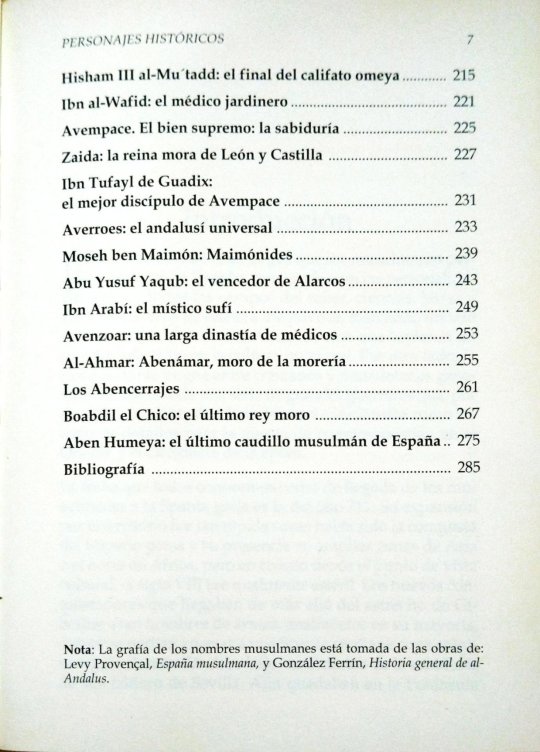
Hisham III al-Mu'tadd: the end of the Umayyad caliphate...............................215
Ibn al-Wafid: the gardener doctor.....221
Avempace. The supreme good: wisdom...................................................225
Zaida: the Moorish Queen of Leon and Castile........................................................227
Ibn Tufayl of Guadix:
the best disciple of Avempace................. ............................ .231
Averroes: the universal Andalusian....233
Moseh ben Maimon: Maimonides..... ..239
Abu Yusuf Yaqub: the winner of Alarcos......................................................243
Ibn Arabi: the Sufi mystic.....................249
Avenzoar: a long dynasty of doctors. ...................................................253
Al-Ahmar: Abenámar, Moor of the Morería. ...,...............................................255
The Abencerrajes. ..................................261
Boabdil the Younger: the last Moorish king ............................................................267
Aben Humeya: the last Muslim leader of Spain................ ..........................................275
Bibliography .............................................285
Note: The spelling of Muslim names is taken from the works of: Levy Provençal,
Muslim Spain, and González Ferrín, General History of al-Andalus.

Introduction
In the long eight hundred years that the Muslims remained in Spain, there were many personalities who, in all the fields of knowledge, sciences, letters and arts, stood out unequivocal, marking a milestone not only in the culture of al-Andalus, but that had a relevant character in universal culture.
On the other hand, the almost constant struggle between Christians and Muslims would also generate a whole series of great warriors who, for example, the infante Don Juan Manuel considered the best gifted for the war of all those who existed in the East and the West of their time.
The date that we all know as the arrival of the Muslims to Gothic Spania dates back to the year 711. Its expansion throughout the territory was so rapid as had been the conquest of the Persian empire and its presencein large areas of Asia or North Africa, but from a cultural point of view, the 8th century was totally sterile. The new conquerors who arrived from beyond the Strait of Gibraltar, were men at arms, mostly illiterate, who could do little contribute to a Christian Spania whose culture continued to develop under the dictates of the wisdom of Saint Isidore of Seville. Still they were left on the Peninsula
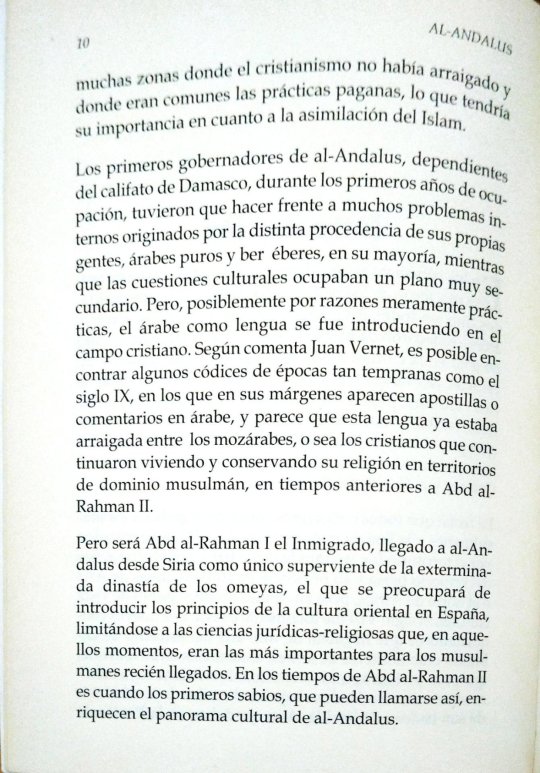
many areas where Christianity had not taken root and its importance regarding the assimilation of Islam.
The first governors of al-Andalus, dependent on Caliphate of Damascus, during the first years of occupation
had to face many enormous internal problems, originated by the different origins of their own people, Arabs
and berebers, mostly, while cultural issues occupied a very secondary level. But, possibly for purely practical reasons, Arabic as a language was introduced into the Christian field. According to Juan Vernet, it is possible to find
some codices from times as early as the 9th century, that in its margins appear apostilles or comments in Arabic,
and it seems that this language was already rooted among the Mozarabs,
that is, the Christians who continued to live and preserve their religion in Muslim-dominated territories, in times
before Abd al-Rahman II.
But it will be Abd al-Rahman I the Immigrant, who arrived in al-Andalus from Syria as the only survivor of the exterminated Umayyad dynasty, the one who will be concerned with introducing the principles of oriental culture in
Spain, limiting itself to the legal-religious sciences that, in those moments, were the most important for the newly Muslims
arrived. It was during the time of Abd al-Rahman II that the first wise men, who can be called that, enrich the cultural landscape of al-Andalus.

Poets, doctors, philosophers, mathematicians, geographers, undefeated generals...All of them will give al-Andalus and Europe a series of works that, by their importance will be translated, searched, accepted and will serve as a basis for the western culture and Renaissance ideas, in such a way that many of the great sages of the Italian Renaissance considered that all knowledge of the time came from Muslim Spain, which all the wise men were of Andalusian origin. And when the political decline and the disintegration of the caliphate, will not stop birth, grow and develop distinguished minds that will continue to maintain,for a long time, the prestige of al-Andalus. Curiously, this situation will be repeated throughout the history of Spain, when the Arab occupation just be a memory. The Spanish Golden Age will coincide with decadence of the Austrias, when the country loses its pre-ponderance in Europe, and with the disaster of '98, with the loss for Spain of its last colonies, will produce a cultural and scientific renaissance that has been called the Silver age.
Through the pages of this book we want to highlight those figures who occupied a predominant place in the history of al-Andalus, although not all of them were necessarily Muslims, since that in that cultured and tolerant al-Andalus, many Jews and some other Christians showed their genius, and of those who, often, we know more about his works than about his biography. But whatever religion they had, they were all, after all, Andalusians, born and raised in the extensive lands of al-Andalus. As a matter of curiosity we will include some groups of characters
anonymous people who, due to their surprising
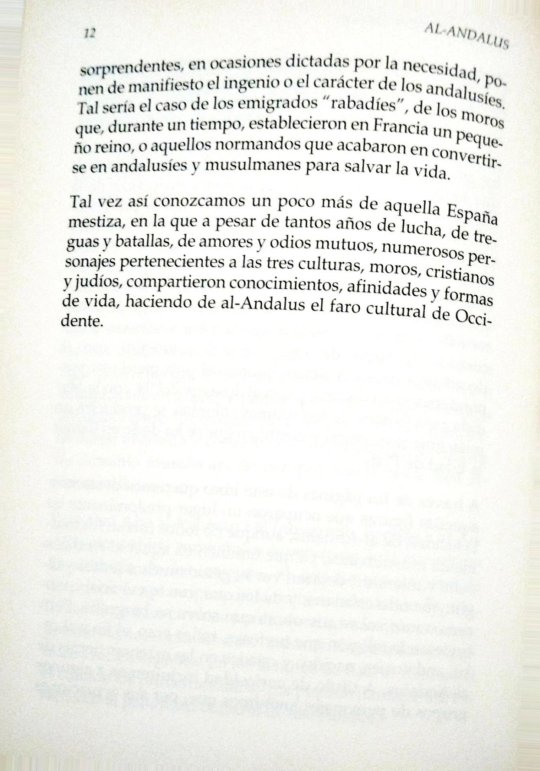
actions, on occasions dictated by necessity, they reveal the ingenuity or character of the Andalusians. Such would be the case of the "rabadíes", of the Moors who, for a time, established a small kingdom in France, or those Normans who ended up becoming Andalusians and Muslims to save their lives.
Perhaps this way we will learn a little more about that crossbred Spain, in which despite so many years of struggle, truces and battles, mutual loves and hates, numerous characters belonging to the three cultures, Moors, Christians and Jews shared knowledge, affinities and forms of
life, making al-Andalus the cultural beacon of the West.

The precursors of al-Andalus
Count Don Julián
The conquest of Morocco had been carried out quickly, but shallow. The Berbers were only subdued after a fierce resistance, defeated by an ambitious general who had just been appointed governor of Ifriqiya and Maghrib. His successes in these lands
They would prepare the ground for him to be the one to set his eyes and, also
his troops, over Gothic Spania. It was Musa ben Nusayr.
Musa, with the help of one of his sons, took possession of Tangier, and demanded that the subjugated tribes hostage to educate them in the new faith, which in turn, became propagandists of Islam, leaving in the conquered Morocco
Arab lieutenants, including General Tariq ben Ziyad, he turned to Ifriqiya. But it seems that the Ceuta square remained
in the hands of a Christian, the so-called Count Don Julián, who would have a
determining role in this entire story. We could consider it as a precursor of that al-Andalus that was about to be born.
#bookblr#book scans#historyblr#history books#al andalus#al andalus. personajes históricos#al andalus. historical figures#history#spanish history#musa ibn nusayr#tariq ibn ziyad#conde don julián#count don julián#count julian
26 notes
·
View notes
Text
Al-Ándalus

Sigue un breve recuento histórico de la dominación musulmana en Iberia:
En el año de 711 Táriq ibn Ziyad, un líder militar bereber originario de lo que hoy constituye Marruecos, desembarcó en la bahía de Algeciras al mando de una fuerza de 7.000 hombres también bereberes en su mayoría . Desde el peñón de Gibraltar (del árabe 'Ŷebel at-Tariq', montaña de Tariq) dirigió ataques sucesivos hacia Andalucía. La península Ibérica estaba entonces bajo el poder de los visigodos. El rey de los visigodos, Rodrigo o Roderic, se enfrentó a los musulmanes en la batalla del río Guadalete donde fue derrotado y muerto. El gobernador yemení de Ifriqiya (actual Tunez) Musa ben Nusayr se unió junto con su ejército de 18.000 hombres a las fuerzas de Tariq y juntos emprendieron la conquista del resto de la península. Toledo, capital del muy centralizado reino visigodo, fue tomada antes de terminar el año 711 y el resto del territorio ibérico, a excepción de Asturias en el norte, cayó bajo control de los musulmanes en unos cuantos años. Tanto Tariq como Musa habían batallado a nombre del Califato Omeya que tenía su base en Damasco.
Los conquistadores musulmanes de la península ibérica le dieron un nuevo nombre a esta, Al-Ándalus. El lenguaje y la cultura berebero-árabe fueron impuestos sobre la población y ocurrieron muchas conversiones al islamismo pero aún las personas que no se convirtieron aprendieron a hablar árabe y fueron denominados mozárabes. También hubo inmigración musulmana desde el norte de África.
En el año de 750 el Califato Omeya de Damasco fue derrotado por los abasíes quienes constituyeron el Califato Abasí con su sede en la ciudad de Baghdad. Los principales omeyas fueron masacrados a excepción de un solo miembro de la familia, Abderramán, quien escapó y terminó refugiándose en Al-Ándalus. Abderramán estableció un emirato independiente del Califato de Baghdad que duró hasta el año de 929.
En el año de 929 se estableció el Califato Fatimí en el norte de África. Los fatimíes se proclamaban como los directos descendientes de la hija del profeta Mahoma, Fátima, y de su esposo y primo Alí. Eran chiitas y su propósito era el de tomar el control político, espiritual, y militar de todo el mundo musulmán. Tenían por lo tanto como objetivo acabar con el Califato Abasí de Baghdad y también sacar del poder a los omeyas de Al-Andalus.
En vista de esta nueva amenaza venida del norte de África el emir Abderramán III decidió fundar un nuevo califato en Al-Ándalus. Éste fue proclamado en el año de 929 y su sede fue establecida en la ciudad de Córdoba.
Durante los años que duró el califato, Córdoba se convirtió en una ciudad de gran importancia cultural, política, y económica y llegó a ser una de las tres ciudades más pobladas del mundo junto con Constantinopla y Baghdad. La agricultura era de las más productivas de Europa y los califas emprendieron obras arquitecturales importantes como la ciudad palatina de Madínat al-Zahra y la Mezquita de Córdoba. La ciudad fue dotada además con cerca de 70 bibliotecas y se convirtió en un imán cultural que atraía a estudiosos de toda Europa. Muchas obras clásicas griegas y romanas fueron traducidas del árabe al latín durante este período lo que sirvió para esparcir el conocimiento clásico por todo el continente. Tuvo un apogéo el estudio de ciencias como la astronomía, la medicina, la filosofía y también artes como la poesía. Entre los famosos eruditos de esta y subsiguientes épocas se pueden mencionar al médico Avenzoar, el filósofo Averroes y el teólogo judío Maimónides.

En el año de 977 surgió un nuevo personaje fuerte en la historia de Al-Andalus. Se trata de Muhammad ibn Abi Amir o Almanzor, hayib o chambelán del débil califa Hisham II, y quien se convirtió en el gobernante de facto del califato. Bajo su liderazgo se emprendieron más de 50 campañas militares exitosas contra los reinos cristianos de León, Castilla, Pamplona, y Cataluña, forzándolos a reconocer la soberanía del califato y a pagar tributos. La muerte de Almanzor en 1002 hizo desatar una guerra civil entre sus herederos y los miembros de la línea de sucesión omeya. El califato no resistió a esta pugna y en el año de 1031 se disolvió, estableciéndose en su lugar pequeños reinos independientes musulmanes llamados taifas.
Las débiles taifas empezaron a ser atacadas por los reinos cristianos del norte y después de que los cristianos se tomaran a Toledo en 1085 decidieron llamar en su ayuda a los guerreros islamistas nómadas del norte de África llamados almorávides. Los almorávides unificaron a Al-Ándalus mas no lograron impedir la continuación de los ataques cristianos.
A los almorávides sucedieron los almohades (también del norte del África) quienes hicieron su incursión en la península en 1172. Se logró una cierta estabilidad que duró algunas décadas. Sin embargo los almohades fueron definitivamente derrotados por una coalición cristiana en el año de 1218 en la Batalla de Navas de Tolosa que les brindó a los cristianos la perspectiva de conquistar todo el valle del río Guadalquivir (actual Andalucía).
En los años de 1230 a 1250 la mayoría de las taifas musulmanas fueron conquistadas por los reinos cristianos de Castilla, León, y Aragón.
El último reino musulmán en la península fue el Emirato Nazarí de Granada establecido en el año de 1238 por Mohamed-Ben-Nazar. Este reino logró una cierta tranquilidad y prosperidad gracias al hecho de que pagaba tributo al reino de Castilla y a cambio obtenía la paz. Granada se volvió un centro comercial importante entre Europa y el Magreb. También se convirtió en un centro cultural de consideración que a la vez servía de refugio a los musulmanes que huían de la Reconquista. A pesar de tener como defensa natural a la Sierra Nevada el Reino Nazarí fue paulatinamente perdiendo territorio frente a la Corona de Castilla.
Tras la unión de Isabel I de Castilla y Fernando II de Aragón en 1479 se consolidó el poder cristiano en la península. Los reyes se concentraron en la toma de Granada como última etapa en el proceso de la Reconquista. La llamada Guerra de Granada duró diez años desde 1482 hasta 1492 tras los cuales se firmaron las Capitulaciones de Granada entre los victoriosos Reyes Católicos y el sultán Boabdil.
El tratado de paz garantizaba derecho de permanencia en territorio ibérico a los musulmanes, sin necesidad de convertirse, a condición de que fueran súbditos pacíficos de la corona. Sin embargo en los siguientes años se emprendió con ímpetu la conversión forzosa de los musulmanes al cristianismo. Mezquitas fueron convertidas en iglesias y libros islámicos fueron quemados.
Los descendientes de los musulmanes de Al-Ándalus se denominaron moriscos. Aunque se convirtieron formalmente al cristianismo mantuvieron sus creencias secretamente. La represión por parte de los reyes cristianos continuó durante el siglo XVI y Felipe II prohibió los cantos tradicionales y el uso de la lengua árabe. Esta intolerancia culminaría en 1609 con la Expulsión de los Moriscos.
Historiadores modernos que han estudiado este período consideran que muchos moriscos eludieron el decreto de expulsión y se quedaron en la península y que otros grupos emigraron para después regresar. En cualquier caso los moriscos en suelo español terminaron integrándose al resto de la población.
La herencia que dejaron siete siglos de ocupación musulmana en Iberia es sobre todo de caracter cultural. Todavía se pueden admirar las obras arquitectónicas de Al-Ándalus como por ejemplo la Mezquita de Córdoba o el palacio de La Alhambra. Alrededor de 4.000 palabras de origen árabe son utilizadas hoy en día en la lengua castellana.
Reciéntemente se han llevado a cabo estudios genéticos de los pobladores de España y se estima que uno de cada 10 españoles tiene antepasados venidos de África del Norte. Esta es una prueba ciéntifica de que poblaciones musulmanas de tamaño importante se integraron a la sociedad cristiana ibérica después de la Reconquista.
youtube
1 note
·
View note
Text

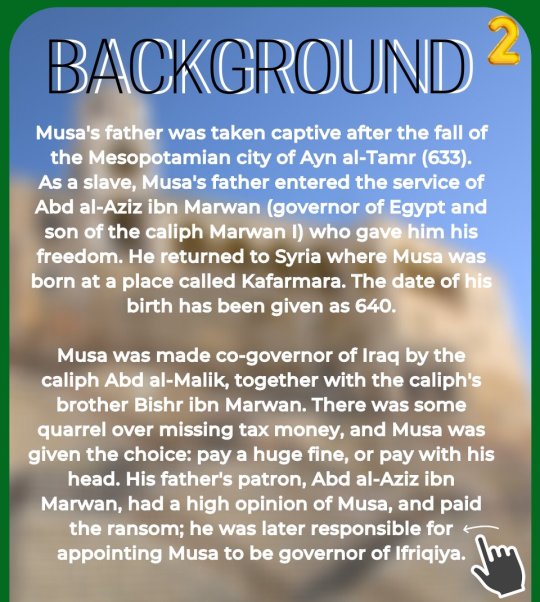




Musa ibn Nusayr served as a Umayyad governor and an Arab general under the Umayyad caliph Al-Walid I. He ruled over the Muslim provinces of North Africa, and directed the Islamic conquest of the Visigothic Kingdom in Hispania.
#musa#background#father#syria#filinta#iraq#islamic#conquest#maghreb#morocco#byzantine#governor#egypt#muslim#andalusia#capital#damascus#solomon#city#spain#arab#death#legacy#hajj#year#peak#north africa#africa#geographer#ibn battuta
0 notes
Photo

(2/2)الفتح الإسلامي للأندلس
Now that Seville is taken, it serves as a center of operations for the launching of armies. 2 armies are sent one to Cordoba and the second to Merida. But the main target remains Toledo capital Visigoth.
Ecija Tarik meets an army of Visigoth who is beaten. He goes to Cordoba who will fall after the surrender of the local count, all the defenders were slaughtered. He goes with his army to knock down other cities Granada, Malaga, Jaen ...
Musa will meet on his way the resistant City of Merida that he will leave behind with a small regiment to continue the siege.
He joins Tarik in front of Toledo which will fall very easily in the hands of Muslims. Indeed, all the dignitaries had already left the city and Musa had the remaining ones killed. Now, Toledo capital Visigoth and his immense treasure from the bag of Rûma in 410 belongs to the Caliphate.
At the beginning of the year 712 operations resume. Musa and Tarik are pursuing the Visigoth armies that had gone back to northern Iberia. The cities of Lugo and Amaya fall as well as all the north of the peninsula so that Muslims own more than half of the provinces of the old kingdom. The only remaining important cities are Tarragona and Narbonne.
This marks the second part of the epic Iberian countryside and marks the beginning of another epic, that of Al-Andalus, but it is another story.
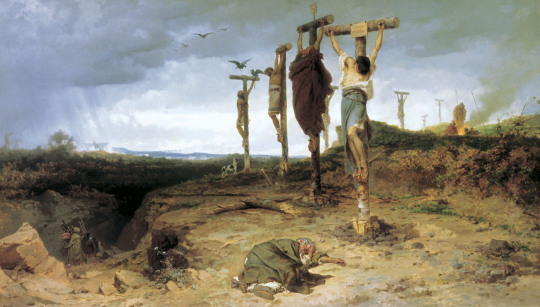
108:1إِنَّا أَعْطَيْنَاكَ الْكَوْثَرَ
0 notes
Photo
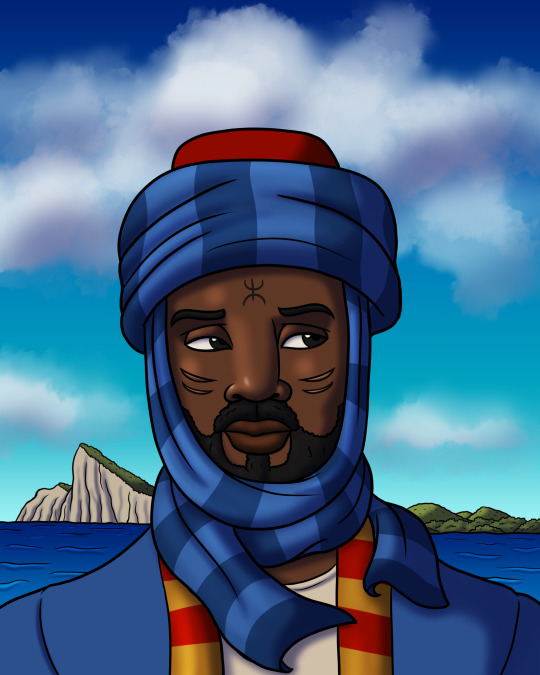
Tariq ibn Ziyad was a Muslim general of native North African origin who led the initial Islamic invasion of Iberia in 711-718 AD. Appointed to his position by the Arab Musa ibn Nusayr, his military successes would result in the Islamicization of al-Andalus (the Arab term for their Iberian provinces) under the Umayyad Caliphate. The Rock of Gibraltar on the Spanish coast, which you can see in the lower left of this composition, derives its modern name from the Arab term Jabal Tariq (“Mountain of Tariq”), named in his honor.
#Tariq ibn Ziyad#muslim#islamic#moorish#north african#amazigh#african#black man#people of color#poc#history#portrait#digital art#art
11 notes
·
View notes
Text
TAFAKKUR: Part 428
AL-ANDALUS: THE LOST CIVILIZATION
How many people now know who Ibn Hazm, Al-Mu’tamid, Ibn Tufayl, Abu Ishaq al-Butruji were, or even where they came from? Most probably, not many. Yet these were among the most important scientists and thinkers of their age and lived in Al-Andalus.
The year 1492 has long been a historical landmark: the Americans recently celebrated the 500th anniversary of Columbus’s ‘discovery’ of the new continent. But there was another 500th anniversary to be marked in 1992. Although this event was also of momentous importance for the history of mankind, it has attracted much less attention. The event we are referring to was the fall of the last Muslim city left in Spain: Granada. The date was the second day of 1492 when the Catholic king of Castile captured the city which had been governed for nearly eight centuries by Muslims.
The Muslim conquest of the Iberian Peninsula, which marked one of the most magnificent and glorious periods in Islamic history began with an invitation from one side of a civil war then raging in Visigothic Spain in 711. Musa Ibn Nusayr, the Umayyad governor of North Africa, was asked to help the rival of a Visigoth king. Thereupon, Nusayr ordered his general Tariq Ibn Ziyad to aid these people with an army of 7,000. In the following years he himself went to Spain. Within seven years the Muslims took control of the whole of the Peninsula, except for Galicia and Austuria. Muslim rule was accepted voluntarily by many Spaniards and over time some of them accepted Islam. The Andalusian Muslims did little to disturb the natives and allowed them to perform their religions and customs. After the dissolution of the central Umayyad government between 1009 and 1031 as a result of uprisings and a succession of weak rulers, a number of independent petty kingdoms (in Arabic mutluk al-tawaif and in Spanish taifa) became established. In spite of the fact that these little kingdoms were weaker than the former Umayyad state, an astonishing flowering of arts and learning took place during the taifa period. One reason for this outstanding development was that each ruler patronized artists, scholars and scientists to gain more prestige than the others. Eventually, the absence of a centrally organized state led to the end of Muslims’ power in the Peninsula. They lost considerable areas of territory to the Christian kingdoms that were reasserting themselves in the north. The petty kingdoms of Al-Andalus asked Yusuf Ibn Tashufin, the Almoravid (in Arabic al-Murabitun) ruler in Morocco, to intervene. They got the help they needed, but in 1090, the Almovarids left the country to its own destiny. This time the taifa kingdoms asked the Almohads (in Arabic al-Muwahhidun) for help. The Almohads willingly accepted and for a period of time they won some success in Spain. Nevertheless, in 1212 at the battle of al-Iqab they were defeated and within a few decades the Almohads were forced back across the Strait of Gibraltar. Muslim cities fell one after another until 1260, when only the kingdom of Granada remained. Granada survived for another two centuries. By the end of 1491, the armies of Ferdinand and Isabella were at the gates of the city. There remained only one final act to be played out on January 2nd, 1492 by which Muslim political sovereignty in Spain came to an end. In 1500, Spanish Muslims were presented with a terrible choice–either to convert to Catholicism or be expelled from Spain. Some did convert, others continued to practice their faith in secret and the rest chose exile.
It is a fact that the Andulusians developed a uniquely plural society whose main features were freedom, tolerance and lack of assimilation–Arabs, Christians, Jews and other immigrants lived side by side in peace for about eight centuries. Cordoba, the capital city of Al-Andalus, was the centre of a sophisticated and rich Islamic-Hispanic civilisation. In its heyday, Cordoba was famous for its intellectually advanced culture, its centres of learning and its great libraries. In those years, there were about one million people, 200,000 houses, 60 palaces, 600 mosques, 700 baths, 17 universities and 70 public libraries in the city. The biggest central library of Cordoba had 400,000 hand-written books and the catalogues which included only the names of the books consisted of 44 volumes. The famous orientalist, Dozy, stated that nearly all the people in Cordoba could read and write.
Gebert of Aurillac, the French monk, later to become Pope Sylvester II, was the first European scholar of importance to study Arabic sciences. He was also responsible for sending many teams of students into Al-Andalus during the closing years of the 10th century. By the end of that century, the various schools in Cordoba employed hundreds of students as translators and just as many copyists working closely to interpret and translate hundreds, perhaps thousands, of manuscripts from Baghdad and Cairo. Through these translations, philosophical and scientific thought from the Greek, Roman and Arab worlds, preserved and expanded upon by Muslim scholars, passed into European consciousness to fuel both the Renaissance and the Age of Enlightenment. Western Europe, in general, owes a great debt to this enormously long and rich intellectual flow from Al-Andalus.
Islamic Spain was an immensely fertile ground for learning, producing a long series of intellectual, aesthetic and scientific advances attributable to Muslim, Christian and Jewish thinkers and the ethos they created. This blossoming was due in part to the spirit of tolerance that prevailed for much of the history of Al-Andalus.
In literature, Ibn Hazm (died in 1013) expanded traditional romantic poetry with his Tawq al-Hamamah (Dove’s necklace). This form of poetry passed from Al-Andalus into North Africa. Islamic literature in Andalus, however, reached its peak during the taifa era when the poet-king of Seville, Al-Mutamid, established an academy of letters, and Ibn Darraj al-Qastalli wrote a series of qasaid (poems) of unequalled beauty.
By the end of 11th century, Al-Andalus was at the forefront of European sciences. The Andalusians excelled in astronomy, both theoretical and practical, perfecting their tables and the precision of their astronomical instruments. Toledo astronomer Al-Zargali, (d. 1087), simplified the Hellenic astrolabe; his version, known as the saphea azarchelis, remained in use until the 16th century. He also anticipated the 17th century German astronomer Johannes Kepler in suggesting that the orbits of the planets are not circular but elliptical.
In medicine, Al-Andalus produced scholars like Al-Zahrawi (d. 1013), who wrote extensively on surgery, pharmacology, medical ethics and the doctor-patient relationship. Ibn Zuhr (known in the west as Avenzoar), a century and a half later, was an advocate of clinical research and practical experimentation. The first medical school in Europe was built in Salerno by Andalusians.
Abdullah Ibn Abdulaziz was one of the best-known geographers and renowned for his great work Al-Masalik wa’l-Mamalik (Roads and Countries). Another important geographer was Al-Idrisi who was educated in Cordoba and wrote Kitab al-Rujari (Roger’s Book) under the patronage of the King of Sicily, Roger II. In this book he divided the world into seven different climatic regions and each region into ten parts. He illustrated his book with some outstanding maps remarkable (and unique) for their accuracy.
Andalusians were also very successful in mathematics, especially geometry. They used the number ‘0’ for the first time in Europe. Among the well-known philosophers who lived in Andalus were Ibn Bajja, Ibn Tufayl and Ibn Rushd all of whom influenced European thought very profoundly. Abu Bakr Ibn Umar, Abu Marwan, Ibn Fradi were particularly famous in historical studies.
Although, over the years, the lost splendour of Al-Andalus has been much idealized in the Islamic world, there remains an appreciation of the factors behind its downfall. Some of these were external, such as the unification and expansion of the Christian kingdoms of Spain and the geographic and political isolation of Al-Andalus from the rest of the Muslim world. There were also internal factors that contributed to the decline of Al-Andalus particularly the rivalries that weakened and divided Muslim Spain, the greed and self-indulgence that gripped its elites, and the loss of inner religious dynamic.
#allah#god#prophet#Muhammad#quran#ayah#sunnah#hadith#islam#muslim#muslimah#hijab#help#revert#convert#dua#salah#pray#prayer#reminder#religion#welcome to islam#how to convert to islam#new convert#new muslim#new revert#revert help#convert help#islam help#muslim help
5 notes
·
View notes
Text
Culture in Focus: Al-Andalus; an overview of Muslim rule in The Medieval Iberian Peninsula (Spain/Portugal) (711-1492 AD) Part I: A confluence of peoples and traditions...
The historical memory of Medieval Europe is varied in terms of focus and broader knowledge in the modern era. The cultures and various peoples that existed during the centuries known as the Middle Ages are varied and rich in complex interwoven societies. The focus of this post shall be what constituted the primary polity for much of the Medieval period in the Iberian Peninsula of southwestern Europe, in modern day Spain, Portugal, Andorra and even the south of France. Though we more or less regard these countries today as traditionally bastions of the Roman Catholic religion with Latin based Romance languages. The fact is from the early 8th to nearly the end of 15th centuries, the Iberian Peninsula had been dominated by an Islamic polity, one in which Arabic was the lingua franca among the elites and the majority population of parts of the peninsula were Muslim, with Christians and Jews living and interacting within that society too, at times relatively harmoniously and other times violently. A well honed hierarchy was established between the three Abrahamic religions and a complex society was formed that lead to some of the most advanced and cultured learning in language, literature, history, science, math, art, religion, philosophy and economics during the Middle Ages took place. That society and region became known as Al-Andalus, the Arabic word from which the region of southern Spain known today as Andalusia takes it name.
Al-Andalus came to be the confluence of many societies in an era so often viewed in black and white terms of an us versus them portrayal between Christianity and Islam. Indeed, these two religions would drive events in and define many aspects of society in Al-Andalus but they were not the sole factors in its being. In fact, it was the fall of the Western Roman Empire during the 5th century would in part set the stage for Al-Andalus. The Roman Empire has been the world’s foremost political, cultural and military superpower, certainly in Europe for several centuries. However, internal strife, corruption and civil war had lead to the empire being divided and co-ruled between two halves, a Western and Eastern half. The empire had transitioned from Roman polytheistic paganism to Christianity with Rome itself being the symbolic head of Christianity with the Papacy. However, the West and East divide became a more practical than just symbolic division as the years rolled on. The Eastern capital became Constantinople and in time the Eastern Roman Empire known to history as the Byzantine Empire would persist in a largely Greek influenced context quite separate from the Latin influenced Western half although it would maintain Roman political machinations.
The year 410 was regarded as a watershed year, Rome, the Eternal City itself was sacked for the first time in 800 years, by barbarians. Namely, the migratory Germanic tribe known as the Visigoths. The Visigoths and the related Ostrogoths were part of a Germanic barbarian confederation called by the Romans, the Goths. They had possibly come from Scandinavia and northeastern Germany and moved down to the Balkans and eventually into Greece and Italy, alternately serving and fighting against the Romans as auxiliaries and eventually partial conquerors. The Visigoths under their King Alaric sacked Rome after a siege in 410 AD. Rome was not even the capital nominally of the empire at the time but the symbolic fall out was tremendous. Migrations of peoples over the next couple of centuries became the dawn of the Early Middle Ages also known as the Dark Ages when classical antiquity of Greece and Rome was said to be lost on the greater whole of Europe for centuries to come. Many of these migrations included Germans, Huns, Slavs and Avars among others. The Visigoths eventually moved from Italy into the south of France and the Iberian Peninsula. Long the Roman territories of Gaul and Hispania respectively, the locals were a mix of Celtic and Iberian peoples who intermixed with Romans and adopted Latin and other Roman cultural aspects. Now the powerful Visigoths ended their migration and established their own kingdom, the Visigothic Kingdom, long promised by those in Rome they had once served. Their Germanic language was the that of the political elite whereas the majority continued to speak the local dialect of Latin while the coexisting Jewish community spoke Hebrew and Aramaic. These descendants of Roman Jews from Judea and Syria and parts of Roman North Africa settled in Hispania forming a community that became known today as the Sephardic Jews. They were subjected to increasing persecution under their Christian overlords. The Visigoths themselves eventually adopted Christianity and for the next 300 years ruled the bulk of the Iberian peninsula.
The Visigoths continued many Roman traditions, such as bathing, use of aqueducts and indeed the Latin dialect persisted among the majority of the populace with the Germanic Goth language being relegated to the German minority in power. The Visigothic nobility was also quite learned and well versed in politics, history, philosophy and science, even later Muslim sources regarding the city of Seville attest to this, dispelling the notion that the ancient Germans were entirely barbarians with no education. However there were also political rivalries and civil war amongst its leadership. Overtime, the Visigoths were increasingly absorbed into the Hispano-Roman culture leaving only traces of their Germanic origins overall. By the time of the 8th century AD, these civil wars would weaken the state for new invaders.
Elsewhere in the world was the Arabian Peninsula and the various Arab tribes that inhabited it, long pagan and polytheistic, they also had Jewish and later Christian influences among their varied nomadic tribes. In the 7th century AD, an Arab named Muhammad begin preaching the core tenets of a new Abrahamic religion of which he was prophet, this religion became of course Islam and in its founders wake the new religion unified the Arabs and later spread rapidly throughout much of greater Eurasia and Africa, forming a religious-political empire known as a caliphate. In the midst of the rise of Islam, the Eastern Roman Empire was at war with the Persian Sassanian Empire for control of the Middle East, wars which exhausted both empires and with little concentrated military force on their southern borders, the Muslim armies post-Muhammad advanced within a few decades time from Arabia into Persia and the borders of India to parts of Anatolia, almost all of Palestine, Syria and Egypt and across the whole of North Africa to the Atlantic Ocean in modern Morocco. The Arab Muslim conquest overran Roman citizens who lived on the coast of North Africa and it also ran into locals, an Afroasiatic people who were the true native inhabitants of the Sahara Desert, various mountains and coastlines of North Africa. These people went by many names and were quite varied, divided into tribes and kingdoms known variously as Numidians, Libyans and Mauri among other names but were collectively, ethnically and linguistically related. They called themselves the Amazigh or “free people” but the Romans called them what translates today in English as the Berbers, a variation of the word barbarians. The Arabs and the Berbers began a long and complex history during the Muslim conquest of North Africa. Many Berbers gradually converted to Islam and many adopted Arab culture and language as part of a cultural synthesis, though the Berbers would retain their own ethnolinguistic and cultural traditions too. They remain the majority population of North Africa outside of Egypt to this very day. Also the view of all Muslims being Arab was challenged even in these early days. Arabs, Berbers, Persians, other Iranians, Syrians and later Turks along with various Europeans who converted to Islam were all different in their culture and language even if united by their religion at least nominally.
The first major caliphate was the Rashidun dynasty, overthrown by the Umayyads in 661 who made Damascus their capital in Syria. The Umayyads controlled lands bordering India in the east all the way to Morocco in the west. It was in the year 711 AD that from Morocco, part of the caliphate’s African province that an Arab and Berber army would turn its eyes northward to Christian Europe, specifically the Iberian Peninsula under the increasingly divided Visigothic Kingdom. A Berber general, by the name Tariq Ibn Ziyad lead an expeditionary force into Hispania, by order of the Arab governor of the city of Tangier, Musa Ibn Nusayr, under the overall rule of Caliph Al-Walid I. The army was made up of mostly Berbers newly converted to Islam and consisting of excellent light cavalry and numbered roughly 7,000 or so troops. The Muslim army in the name of Umayyad Caliphate was according to legend helped by a renegade European count named Julian of Ceuta who supposedly wanted to avenge the dishonoring of his daughter (meaning rape) by the hands of the Visigoth king, Roderic. Julian supposedly ferried and provided the Muslims with intelligence in an effort to overthrow the Visigoths. The extent of truth to this tale is debated but it is the commonly cited source for the Muslim invasion of Iberia.
Tariq landed in April 711 AD near the modern day British territory of Gibraltar, indeed the famed Gibraltar Rock, one of the Pillars of Hercules in antiquity gets its name Gibraltar from Tariq himself (Djabal Tarik). His force began raiding and sacking Iberian towns, necessitating a Visigoth response. Roderic met the Muslim force within a few months with an army numbering 25,000. Exact sources on the battle that followed, known as the Batlle of Guadalete in July 711 aren’t definite in its details. Most typically it is said that Roderic lead his troops in the center pushing against the Muslim force, only to be betrayed and abandoned by his subordinates on the wings due to their own personal reasons and deceit supposedly prearranged. The Berber cavalry charged at the “sudden” opening on the now abandoned Visigoth center and what followed was a surrounding and destruction of the Visigoth force that remained loyal to Roderic, the king himself being slain, dying valiantly in battle. Visigoth losses were high while the Berbers lost nearly 3,000 of their own men. Those who betrayed Roderic were eventually pursued and slain too by the Muslim forces who got fresh Berber and Arab reinforcements from Tangiers. The military rank and file was predominantly Berber with Arab and Arabized Berbers in command. However, the Arabs and Berbers had an ethnic and cultural tension that persisted not only in the military but would exist throughout Al-Andalus’s history. Arabs typically though numerically inferior were viewed as the top of the hierarchy, with Berbers and other non-Arab Muslims enjoying a second tiered but still relatively privileged placement in Al-Andalus society, though more on this social hierarchy and its implications later on. For now, the Muslim conquest spread rapidly in Iberia like almost anywhere else. The truth lies in the fact that civil war had indeed weakened the Visigoths and their disunity against a mostly unified force was their undoing. Many cities were taken in rapid succession, most notably Cordoba which was to become the center piece and capital of Al-Andalus in the coming years and indeed an important Islamic city on par with Damascus and Baghdad, rivaling Constantinople in terms of size. Tariq served as temporary governor of Iberia as the Visigoths fled north retreating to the mountains of the Spanish and French border, the Pyrenees. Musa Ibn Nusayr took over governorship in 713 though both were recalled by the Caliph back to Syria in 714 where they lived out their remaining days.
The Muslim foothold on Iberia was firmly established within a couple year span, forming the basis for a new society, Al-Andalus. With its new Muslim overlords of Arab and Berber extraction, its Christian majority of mostly Hispano-Roman origin, their former Visigothic rulers and a Sephardic Jewish community that had been long persecuted by the Visigoths and other Christians, new questions were being raised...What would this new society look like? Could these various peoples coexist? How far would Al-Andalus and by extension Muslim rule spread into Europe? Especially since Muslim Arabs had attempted and failed to take Constantinople in the east on more than one occasion, this expansion into Iberia was seen as a vindication of sorts. Iberia had become a confluence of at least five different peoples with three religions between them, the coming decades would answer the aforementioned questions in the cementing of a new polity...



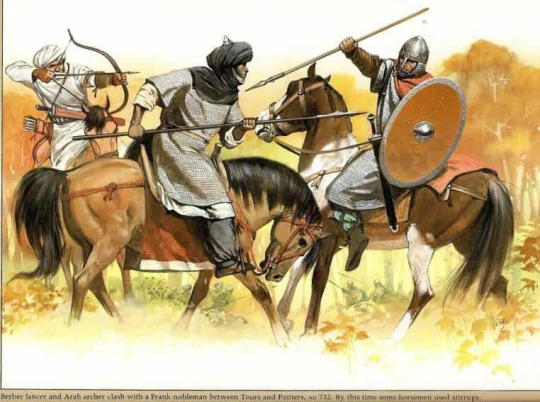
#iberia#spain#portugal#andorra#france#dark ages#middle ages#medieval#visigoths#moors#berbers#roman empire#hispania#arabs#morocco#8th century#cordoba#andalusia#al andalus#sephardic#jews#christians#muslims
24 notes
·
View notes
Text
طارق بن زیاد کی ہسپانیہ (اسپین) کی فتح اور جبل طارق
طارق بن زیاد بَربَر نسل سے تعلق رکھنے والے مسلم سپہ سالار اور بَنو اُمیّہ کے جرنیل تھے ،جنہوں نے 711ء میں ہسپانیہ (اسپین) میں عیسائی حکومت کا خاتمہ کر کے یورپ میں مسلم اقتدار کا آغاز کیا۔ انہیں اسپین کی تاریخ کے اہم ترین عسکری رہنماؤں میں سے ایک سمجھا جاتا ہے۔ شروع میں وہ اموی صوبے کے گورنر موسیٰ بن نصیر کے نائب تھے، جنہوں نے ہسپانیہ میں وزیگوتھ بادشاہ کے مظالم سے تنگ عوام کے مطالبے پر طارق کو ہسپانیہ پر چڑھائی کا حکم دیا۔ طارق بن زیاد نے مختصر فوج کے ساتھ یورپ کے عظیم علاقے اسپین کو فتح کیا اور یہاں دینِ اسلام کاعَلم بلند کیا۔
اسپین کی فتح اور یہاں پراسلامی حکومت کا قیام ایک ایسا تاریخی واقعہ ہے، جس نے یورپ کو سیاسی، معاشی اور ثقافتی پسماندگی سے نکال کر ایک نئی بصیرت عطا کی اور اس پر ناقابل فراموش اثرات مرتب کیے تھے۔ طارق بن زیاد کی تعلیم و تربیت موسیٰ بن نصیر کے زیر نگرانی ہوئی تھی، جو ایک ماہرِ حرب اور عظیم سپہ سالار تھے۔ اسی لیے طارق بن زیاد نے فن سپہ گری میں جلدہی شہرت حاصل کر لی۔ ہرطرف ان کی بہادری اور عسکری چالوں کے چرچے ہونے لگے۔ طارق بن زیاد بن عبداللہ نہ صرف دنیا کے بہترین سپہ سالاروں میں سے ایک تھے بلکہ وہ متّقی، فرض شناس اور بلندہمت انسان بھی تھے۔ ان کے حْسنِ اخلاق کی وجہ سے عوام اور سپاہی انہیں احترام کی نظر سے دیکھتے تھے۔
افریقہ کی اسلامی سلطنت کو اندلس کی بحری قوّت سے خطرہ لاحق تھا، جب کہ اندلس کے عوام کا مطالبہ بھی تھا۔ اسی لیے گورنر موسیٰ بن نصیر نے دشمن کی طاقت اور دفاعی استحکام کا جائزہ لے کر طارق بن زیاد کی کمان میں سات ہزار (بعض مؤرخین کے نزدیک بارہ ہزار) فوج دے کر انہیں ہسپانیہ کی فتح کے لیے روانہ کیا۔ 30 اپریل 711ء کواسلامی لشکر ہسپانیہ کے ساحل پر اترا اور ایک پہاڑ کے نزدیک اپنے قدم جما لیے، جو بعد میں طارق بن زیاد کے نام سے جبل الطارق کہلایا۔ طارق بن زیاد نے جنگ کے لیے محفوظ جگہ منتخب کی۔ اس موقع پر اپنی فوج سے نہایت ولولہ انگیز خطاب کیا اورکہا کہ ہمارے سامنے دشمن اورپیچھے سمندر ہے۔ جنگ سے قبل انہوں نے اپنے تمام بحری جہازوں کو جلا دینے کا حکم دیا تا کہ دشمن کی کثیر تعداد کے باعث اسلامی لشکر بد دِل ہو کر اگر پسپائی کا خیال لائے تو واپسی کا راستہ نہ ہو۔ اسی صورت میں اسلامی فوج کے پاس صرف ایک ہی راستہ باقی تھا کہ یا تو دشمن کو شکست دے یا اپنی جان جانِ آفرین کے سپرد کر دے۔ یہ ایک ایسی زبردست جنگی چال تھی کہ جس نے اپنی اہمیت کی داد آنے والے عظیم سپہ سالاروں سے بھی پائی۔
7 ہزار کے مختصراسلامی لشکر نے پیش قدمی کی اور عیسائی حاکم کے ایک لاکھ کے لشکر کا سامنا کیا، گھمسان کا رَن پڑا، آخر کار دشمن فوج کو شکست ہوئی اورشہنشاہ راڈرک مارا گیا، بعض روایتوں کے مطابق وہ بھاگ نکلا تھا، جس کے انجام کا پتا نہ چل سکا۔ اس اعتبار سے یہ جنگ فیصلہ کن تھی کہ اس کے بعد ہسپانوی فوج کبھی متحد ہو کر نہ لڑ سکی۔ فتح کے بعد طارق بن زیاد نے بغیر کسی مزاحمت کے دارالحکومت طلیطلہ پر قبضہ کرلیا۔ طارق بن زیاد کو ہسپانیہ کا گورنر بنا دیا گیا۔ طارق بن زیاد کی کامیابی کی خبرسن کر موسیٰ بن نصیر نے حکومت اپنے بیٹے عبداللہ کے سپرد کی اورخود طارق بن زیاد سے آ ملے۔ دونوں نے مل کر مزید کئی علاقے فتح کیے۔ اسی دوران خلیفہ ولید بن عبدالملک نے اپنے قاصد بھیج کر دونوں کو دمشق بلوا لیا اور یوں طارق بن زیادہ کی عسکری زندگی کا اختتام ہوا۔ اسلامی دنیا کے اس عظیم فاتح نے 720ء وفات پائی۔
عتیق احمد
#Tariq Ibn Ziyad#Spain#Muslims warriors#Muslims#Muslim Generals#Musa bin Nusayr#Jabal Tariq#Islam#Hispania
0 notes
Text
If anyone wants to read new historical fiction related to the Abd al-Aziz chapter of the Al Andalus. Historical Figures book, recently a novel has been published. This novel is Egilona, Reina de Hispania (Egilona, Queen of Hispania), writen by José Soto Chica. The bulk of the story is based on the texts of the Mozarabic Chronicle and Arabic sources such as the Fath al-Andalus codex, the anonymous Ajbar Maimu'a or the works of the historian Al-Maqqari and the caliph Al-Hakam. In fact, all chapters begin with a fragment of these writings.

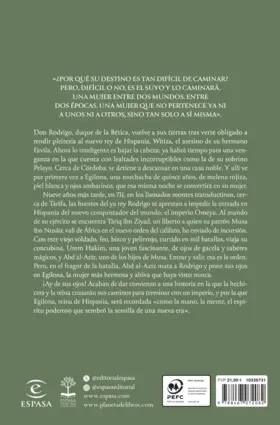
Synopsis
Egilona, the last queen of Hispania, a powerful woman between two cultures, between two eras, the Gothic and the Arab, fascinates us in this memorable historical novel.
Don Rodrigo, Duke of Bética, returns to his lands after being forced to pay homage to the new king of Hispania, Witiza, the murderer of his brother Favila. Now the smart thing is to lower his head; There will be time for revenge. Near Córdoba, he stops to rest in a noble house and there he sees for the first time Egilona, a fifteen-year-old girl with reddish hair, white skin and amber eyes, who that same night will become his wife.
Nine years later, in 711, near Tarifa, the hosts of the now king Rodrigo prepared to prevent the entry into Hispania of the new conqueror of the world: the Umayyad empire. In command of his army is Tariq ibn Ziyad, a freedman whom his patron Musa ibn Nusayr, vali of Africa in the new order of the caliphate, has sent on a raid. With this old soldier, ugly, cross-eyed and red-haired, hardened in a thousand battles, travels his concubine, Umm Hakim, a fascinating young woman, with doe eyes and magical knowledge, and Abd al-Aziz, one of Musa's sons. In and out, that's the order. But, in the heat of battle, Abd al-Aziz kills Rodrigo and sets his sights on Egilona, the most beautiful and haughty woman he has ever seen.
Woe to his eyes! They have just begun a story in which the sorceress and the queen will cross paths to end an empire, and for which Egilona, queen of Hispania, will be remembered "as the hand, the mind, the powerful spirit that sowed the "seed of a new era."
Some comments from the author of the novel about the historical figure of Egilona, the historical setting, the conquest and her marriage to Abd al-Aziz, from this interview:
"Events that have usually been told very poorly"
"She was a transitional character who was everything with the Visigoths and is everything again in the new world of the Muslims, but a lot of nonsense has been written about her"
"I have opted for an intermediate solution in the novel"
"After Rodrigo's death it stands as a symbol of resistance, but after the second defeat of the Visigoths in Écija I made Al-Aziz capture it. Let's think about Aztec Mexico: the Spanish were a very small force and they relied on the nobility. The Arabs did the same. This marriage was not the exception, but the norm, and there are the examples of Teodomiro's daughter or Witiza's granddaughters. It was a time when collaboration was needed"
"If I put on my historian's suit and limit myself to what the sources say, I am tied hand and foot. Now, a novelist does have licenses and I imagine that story of hate and love with Al-Aziz"
"But I think the result is very coherent: it is a novel by a historian who specializes in the period and which, literary speaking, proposes psychological solutions to the 8th century."
"For me, her forgetfulness is intentional from her own time: for those who resisted in Asturias she was a traitor; for the Arabs, she was responsible for the perfect Muslim warrior falling into the conspiracy. She was guilty for going over to the enemy or subverting the order, and this has greatly influenced nineteenth-century and current Spanish historiography"
"This novel, at the level of people who seek to learn history with fiction, is the story of the Islamic conquest of Hispania based on what we really know, which has changed a lot in the last twenty years"
"It's not about good ones and bad ones, but about people like us who have to survive by accepting that the world has changed or by rebelling against it."
#egilona reina de hispania#egilona queen of hispania#bookblr#historical fiction#novel#books#josé soto chica#queen egilona#ailo#king rodrigo#rodrigo king of the goths#abd al-aziz ibn musa#abd al aziz#musa ibn nusayr#tariq ibn ziyad#book scans related#hispania#al andalus#spania#rey don rodrigo#umm hakim
15 notes
·
View notes
Text
Second part of the bookscans of Al Andalus. Historical Figures, here's the previous part
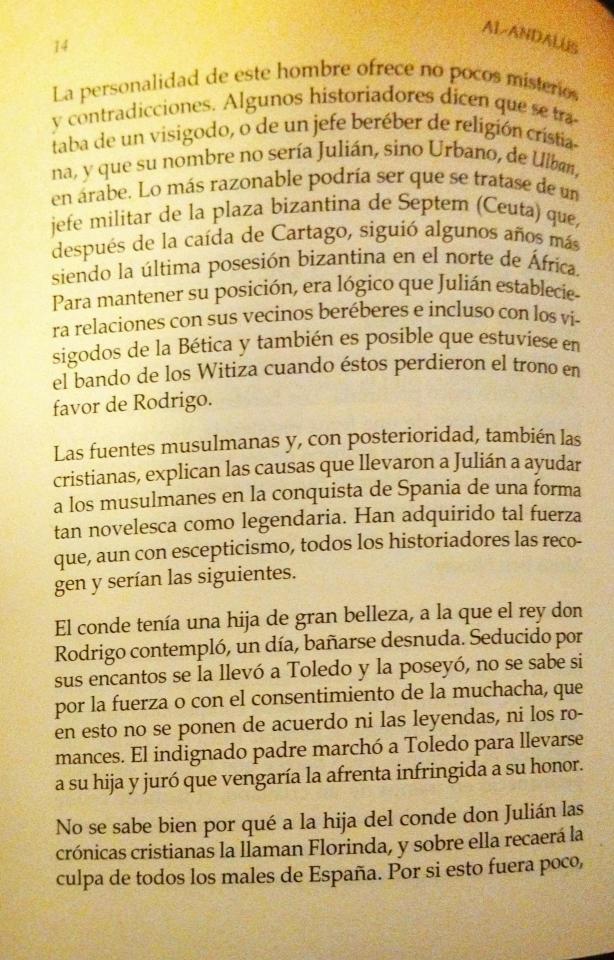
The personality of this man offers many mysteries and contradictions. Some historians say that he was a Visigoth, or a Berber of Christian religion, and that his name would not be Julián, but Urban, from Ulban, in Arabic. The most reasonable thing could be that he is a military commander from the Byzantine square of Septem (Ceuta) which, after the fall of Carthage, continued to be the last Byzantine position in North Africa for a few more years. To maintain his position, it was logical that Julián established relations with his Berber neighbors and even the Visigoths of Baetica and it is also possible that he was on the side of the Witizas when they lost the throne in favor of Rodrigo.
The Muslim sources and, later, also the
Christians, explain the causes that led Julián to help the Muslims in the conquest of Spania in such a way
novel as well as legendary. They have acquired such strength that, even
with skepticism, all historians collect them and they would be the following.
The count had a daughter of great beauty, whom the king Rodrigo, one day, contemplated her bathing naked. Seduced by her charms he took her to Toledo and possessed her, it is not known if because of force or with the consent of the girl, who in this neither legends nor romances agree. The indignant father marched to Toledo to take his daughter and swore
that he would avenge the affront inflicted on her honor.
It is not well known why the daughter of Count Don Julián is called Florinda in Christian chronicles, and on her will fall the
blame for all the ills of Spain. As if this were not enough,
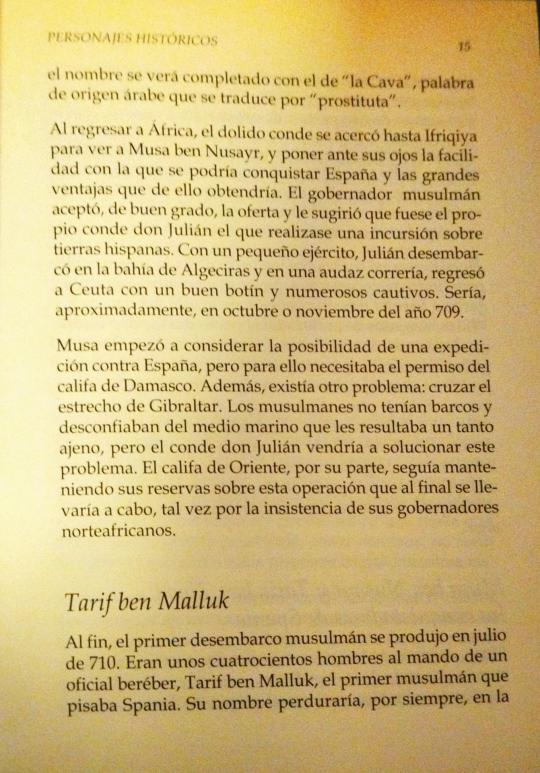
the name will be completed with “la Cava”, a word of Arabic origin which translates to "prostitute".
Upon returning to Africa, the hurt count went to Ifriqiya to see Musa ben Nusayr, and put before his eyes the ease with which one could conquer Spania and the great advantages that would be obtained from it. The Muslim governor willingly accepted the offer and suggested that it would be Count Don Julián himself who carried out an incursion onHispanic lands. With a small army, Julian landed in the bay of Algeciras and in a daring raid, he returned to Ceuta with good loot and numerous captives. It would be approximately October or November of the year 709.
Musa began to consider the possibility of an expedition against Spania, but for this he needed the permission of the Caliph of Damascus. In addition, there was another problem: crossing the Strait of Gibraltar. The Muslims did not have ships and distrusted the marine environment that they considered a bit strange, but Count Don Julián would come to solve this problem. The Caliph of the East, for his part, continued to maintain his reservations about this operation that would ultimately be carried out, perhaps because the insistence of their North African governors.
Tarif ben Malluk
Finally, the first Muslim landing occurred in July 710. There were about four hundred men under the command of a Berber officer, Tarif ben Malluk, the first Muslim to set foot in Spania. His name would last, forever, in the
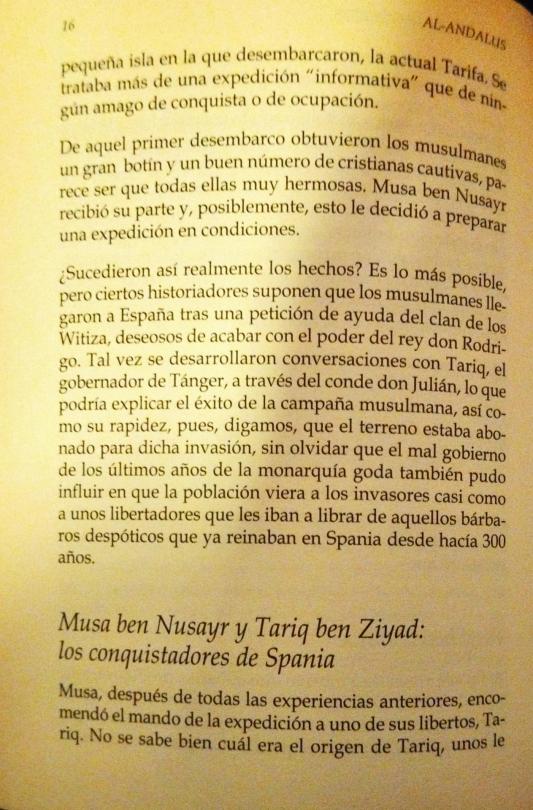
small island where they landed, the current Tarifa. It was more of an “informative” expedition than a threat of conquest or occupation.
From that first landing the Muslims obtained Muslims obtained a
great booty and a good number of captive Christian women, it seems to be
that all of them are very beautiful. Musa ben Nusayr received his part and, possibly, this decided him to prepare a proper expedition.
Did the events really happen like this? It is the most possible, butcertain historians suppose that the Muslims came to
Spania after a request for help from the Witiza clan, eager to put an end to the power of King Don Rodrigo. Maybe
conversations took place with Tariq, the governor of Tangier, through Count Don Julián, which could explain the
success of the Muslim campaign, as well as its speed, therefore, let's say that the ground was fertile for said invasion,
without forgetting that the bad government of the last years of the
Gothic monarchy could also influence the population to see the invaders almost as if they were liberators who were going to
rid of those despotic barbarians who already reigned in Spania for 300 years.
Musa ben Nusayr and Tariq ben Ziyad:
the conquerors of Spania
Musa, after all the previous experiences, entrusted the command of the expedition to one of his freedmen, Tariq.
It is not well known what Tariq's origin was, some
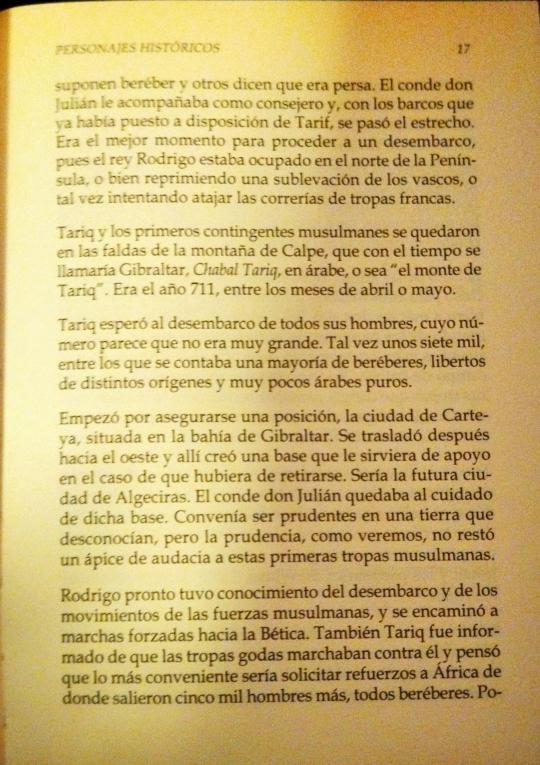
assume he was Berber and others say he was Persian. Count Don Julián
accompanied him as a counselor and, with the ships that he had already put to
Tarif's disposition, the strait was crossed. It was the best time to proceed to landing, since King Rodrigo was busy in the
north of the Peninsula, or repressing an uprising of the Basques, or perhaps trying to stop the raids of Frankish troops.
Tariq and the first Muslim contingents stayed in the foothills of the Calpe mountain, which in time would be called Gibraltar, Chabal Tariq, in Arabic, that is, “the mountain of Tariq.” It was the year 711,
between the months of April or May.
Tariq waited for all his men to disembark, whose number seems like it wasn't very big. Perhaps seven thousand, among whom the majority were Berbers, freedmen of different origins and
very few pure Arabs.
He began by securing a position, the city of Carteya, located in the bay of Gibraltar. He then moved west and there created
a base that would serve as support in the event that it had to backing out. It would be the future city of Algeciras. Count Don Julián was in the care of said base. It was advisable to be cautious in a
land that they did not know, but prudence, as we will see, did not took less audacity to these first Muslim troops.
Rodrigo soon learned of the landing and the movements of the Muslim forces, and set out on marches forced towards Baetica. Tariq was also informed that the
Gothic troops were marching against him and he thought that the most convenient
would be to request reinforcements from Africa where five thousand men came from
more, all Berbers. Po-
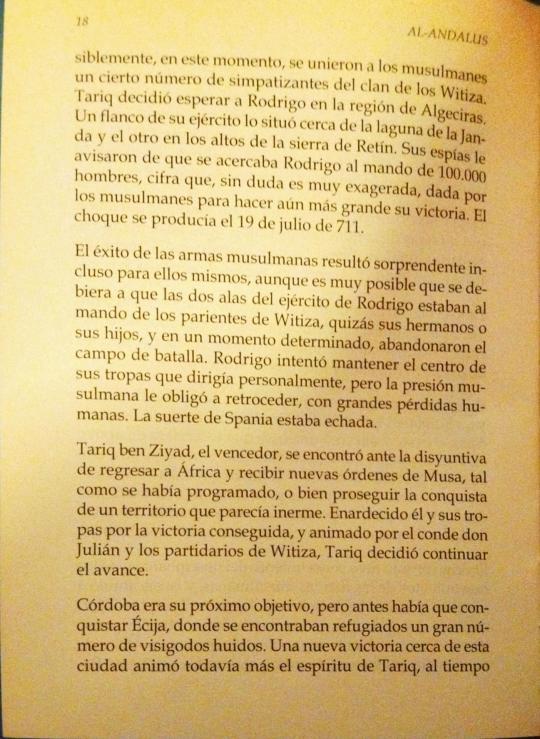
ssibly, at this time, the Muslims were joined by a certain number of sympathizers of the Witiza clan. Tariq decided
wait for Rodrigo in the region of Algeciras. One flank of his army was placed near the Janda lagoon and the other on the heights of the Retín mountain range. His spies warned him that Rodrigo was approaching
commanding 100,000 men, a figure that is undoubtedly very exaggerated, given by the Muslims to make even bigger their victory. The clash occurred on July 19, 711.
The success of Muslim weapons was surprising even for themselves, although it is very possible that it was because
the two wings of Rodrigo's army were commanded by the relatives of Witiza, perhaps his brothers or his children, and in a certain moment, they left the battlefield. Rodrigo tried to hold the center of his troops that he led personally, but Muslim pressure forced him to retreat,
with great human losses. Spania's luck was
cast.
Tariq ben Ziyad, the victor, found himself faced with the dilemma of returning to Africa and receiving new orders from Musa, as had been scheduled, or continuing the conquest of a territory that seemed defenseless. He and his troops were enraged by the victory achieved, and encouraged by Count Don Julián and Witiza's supporters, Tariq decided to continue the advance.
Córdoba was their next objective, but first they had to conquer Écija, where a large number of escaped Visigoths were taking refuge. A new victory near this city encouraged Tariq's spirit even more, while
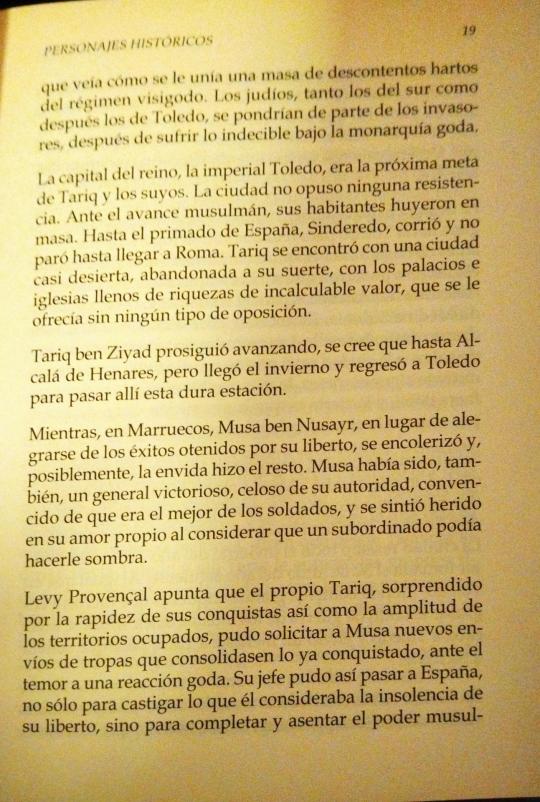
he saw how he was joined by a mass of dissatisfied people fed up with the Visigothic regime. The Jews, both those of the south and later those of Toledo, would side with the invaders, after suffering the unspeakable under the Gothic monarchy.
The capital of the kingdom, the imperial Toledo, was the next goal of Tariq and his people. The city did not put up any resistance. Faced with the Muslim advance, its inhabitants fled. Even the primate of Spania, Sinderedo, ran away and did not stop until he reached Rome. Tariq found an almost deserted city, abandoned to its fate, with palaces and churches full of riches of incalculable value, which were offered to him without any type of opposition.
Tariq ben Ziyad continued advancing, it is believed as far as Alcalá de Henares, but winter arrived and he returned to Toledo to spend this hard season there.
Meanwhile, in Morocco, Musa ben Nusayr, instead of rejoicing at the successes achieved by his freedman, became angry and, possibly, envy did the rest. Musa had also been a victorious general, jealous of his authority, convinced that he was the best of soldiers, and he felt hurt in his self-esteem when he considered that a subordinate could overshadow him.
Levy Provençal points out that Tariq himself, surprised by the speed of his conquests as well as the breadth of the occupied territories, was able to request new shipments of troops from Musa to consolidate what had already been conquered, fearing a Gothic reaction. His leader was thus able to go to Spania, not only to punish what he considered the insolence of his freedman, but to complete and establish Mus-
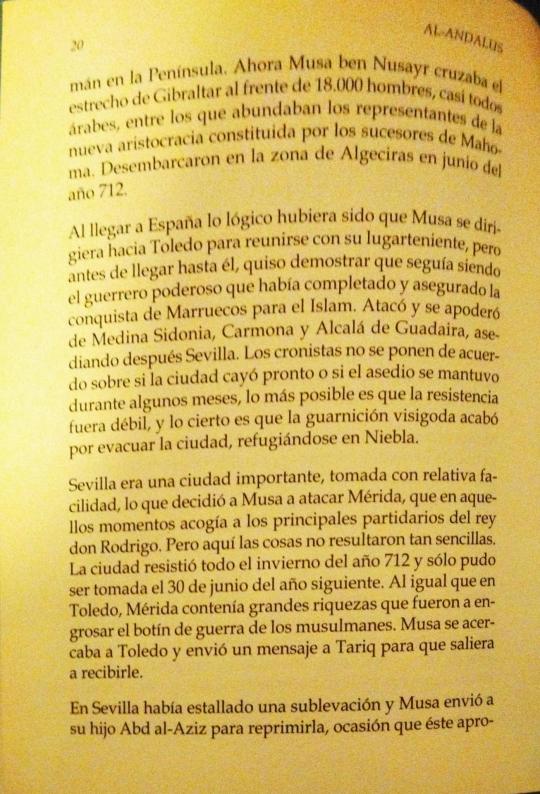
lim power on the Peninsula. Now Musa ben Nusayr crossed the Strait of Gibraltar at the head of 18,000 men, almost all Arabs, among whom were many representatives of the new aristocracy formed by the successors of Muhammad. They landed in the area of Algeciras in June of the year 712.
Upon arriving in Spania, it would have been logical for Musa to head towards Toledo to meet with his lieutenant, but before reaching him, he wanted to demonstrate that he was still the powerful warrior who had completed and ensured the conquest of Morocco for Islam. He attacked and took control of Medina Sidonia, Carmona and Alcalá de Guadaira, later besieging Seville. The chroniclers do not agree on whether the city fell soon or if the siege continued for a few months; it is most likely that the resistance was weak, and the truth is that the Visigoth garrison ended up evacuating the city, taking refuge in Niebla.
Seville was an important city, taken with relative ease, which decided Musa to attack Mérida, which at that time hosted the main supporters of King Don Rodrigo. But here things were not so simple. The city resisted throughout the winter of 712 and could only be taken on June 30 of the following year. As in Toledo, Mérida contained great riches that added to the war loot of the Muslims. Musa was approaching Toledo and sent a message to Tariq to come out to meet him.
An uprising had broken out in Seville and Musa sent his son Abd al-Aziz to suppress it, an opportunity that he took advantage
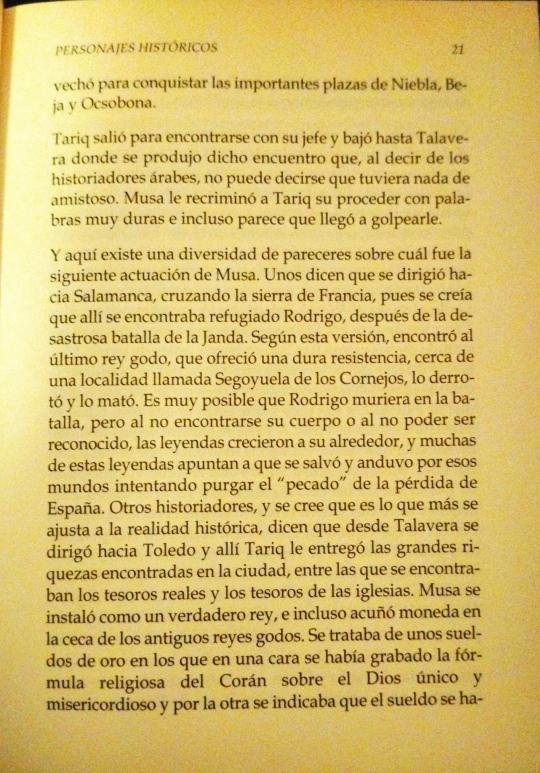
to conquer the important squares of Niebla, Beja and Ocsobona.
Tariq left to meet his boss and went down to Talavera where this meeting took place which, according to Arab historians, cannot be said to have had anything friendly. Musa reproached Tariq for his behavior with very harsh words and it seems that he even hit him.
And here there is a diversity of opinions about what Musa's next performance was. Some say that he headed towards Salamanca, crossing the Sierra de Francia, since it was believed that Rodrigo was taking refuge there after the disastrous battle of La Janda. According to this version, he found the last Gothic king, who offered tough resistance, near a town called Segoyuela de los Cornejos, defeated him and killed him. It is very possible that Rodrigo died in battle, but since his body was not found or could not be recognized, legends grew around him, and many of these legends suggest that he was saved and walked through those worlds trying to purge the “sin” of the loss of Spania. Other historians, and it is believed that this is what most closely corresponds to historical reality, say that from Talavera he headed towards Toledo and there Tariq gave him the great riches found in the city, among which were the treasures royals and the treasures of the churches. Musa installed himself as a true king, and even minted coins in the mint of the ancient Gothic kings. They were golden salaries on which the religious formula of the Koran about the only and merciful God had been engraved on one side and on the other it indicated that the salary had been
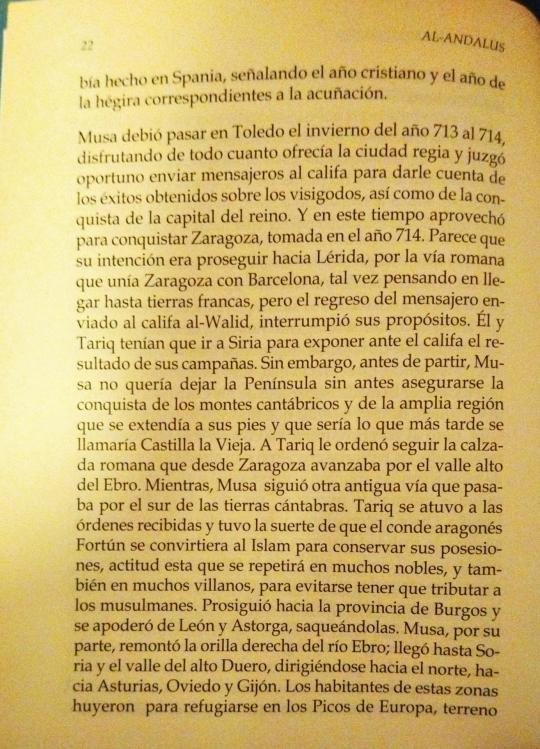
made in Spania, indicating the Christian year and the year of the hegira corresponding to the coinage.
Musa had to spend the winter from 713 to 714 in Toledo, enjoying everything that the royal city offered and considered it appropriate to send messengers to the caliph to inform him of the successes obtained against the Visigoths, as well as the conquest of the capital of the Kingdom. And at this time he took the opportunity to conquer Zaragoza, taken in the year 714. It seems that his intention was to continue towards Lleida, along the Roman road that linked Zaragoza with Barcelona, perhaps thinking of reaching Frankish lands, but when the messenger returned sent to the caliph al-Walid, interrupted his purposes. He and Tariq had to travel to Syria to present the results of their campaigns to the caliph. However, before leaving, Musa did not want to leave the Peninsula without first securing the conquest of the Cantabrian Mountains and the wide region that extended at its feet and which would later be called Old Castile. Tariq was ordered to follow the Roman road that advanced from Zaragoza through the upper Ebro valley. Meanwhile, Musa followed another ancient route that passed through the south of the Cantabrian lands. Tariq followed the orders he received and was lucky that the Aragonese count Fortún converted to Islam to preserve his possessions, an attitude that was repeated by many nobles, and also by many villains, so as not to have to pay taxes to Muslims. He continued towards the province of Burgos and took control of León and Astorga, plundering them. Musa, for his part, went up the right bank of the Ebro River; He reached Soria and the upper Duero valley, heading north towards Asturias, Oviedo and Gijón. The inhabitants of these areas fled to take refuge in the Picos de Europa mountain range, terrain
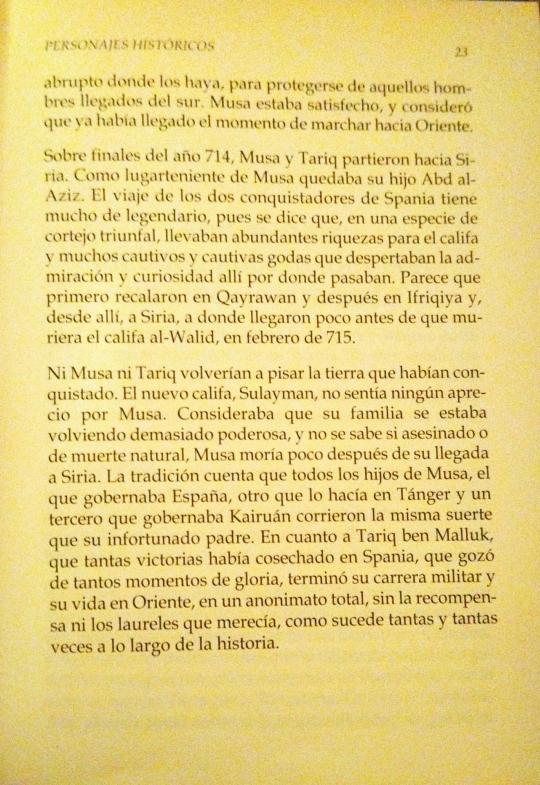
very abrupt, to protect themselves from those men arriving from the south. Musa was satisfied, and considered that the time had come to march towards the East.
Around the end of the year 714, Musa and Tariq left for Syria. Musa's lieutenant was his son Abd al-Aziz. The journey of the two conquerors of Spania is very legendary, since it is said that, in a kind of triumphal procession, they brought abundant riches for the caliph and many Gothic captives who aroused admiration and curiosity wherever they passed. It seems that they first landed in Qayrawan and then in Ifriqiya and, from there, to Syria, where they arrived shortly before the death of the Caliph al-Walid, in February 715.
Neither Musa nor Tariq would return to set foot on the land they had conquered. The new caliph, Sulayman, had no appreciation for Musa. He considered that his family was becoming too powerful, and it is not known whether murdered or a natural death, Musa died shortly after his arrival in Syria. Tradition says that all of Musa's sons, the one who ruled Spania, another who ruled in Tangier and a third who ruled Kairouan, suffered the same fate as their unfortunate father. As for Tarif ben Malluk, who had won so many victories in Spania, who enjoyed so many moments of glory, he ended his military career and his life in the East, in total anonymity, without the reward or laurels he deserved, as happens so many times throughout history.
#bookblr#historyblr#al andalus#al andalus. historical figures#al-andalus. personajes históricos#al andalus history#book scans#the conquest of al-andalus#fath al andalus#la conquista de al andalus#tariq ibn ziyad#musa ibn nusayr#tarif ibn malik#conde don julián#count don julián#julián de ceuta#spanish history
10 notes
·
View notes
Text
c. 711, colorized

Sorry I had to do this meme (btw, here's a medieval depiction of Tariq ibn Ziyad):

#memes#history memes#historyblr#al andalus#conde don julián#tariq ibn ziyad#musa ibn nusayr#tarif ibn malik#711#count don julián#count julian#julián de ceuta
8 notes
·
View notes
Text
Recently I have found a period drama about Tariq ibn Ziyad and the conquest of the Iberian Peninsula, so I thought it's an appropiate to share it now because of the bookscans of AL-ANDALUS. Historical figures. This period drama is a Kuwaiti-Syrian series from 2022, Fath Al-Andalus (The Conquest of Al Andalus), that has 30 episodes so far.
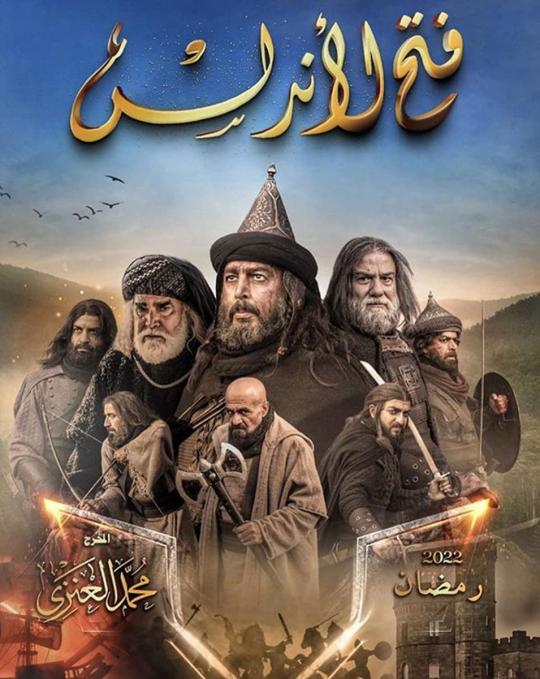

(There are ships on fire on the second poster, maybe in the series there's a scene or a reference about the legend of Tariq burning the ships after arriving to the Iberian Peninsula?)
I haven't watch it (yet), but in YouTube there's a watch list of the 30 episodes with subtitles.
As far as I know there has been controversies about this series in Morocco due to some historical inaccuracies, like erasing Tariq's Amazigh origins and undervalue the role of the Amazigh people in the conquest of Al Andalus.
Main cast
Suhail Jabei as Tariq ibn Ziyad
Taiseer Edris as Rodrigo, King of the Goths
Rafik Ali Ahmad as Musa ibn Nusayr
Pierre Dahger as Julián, Count of Ceuta
Marah Hijaz as Princess Florinda
Akef Najem as Abu Basir, the Judge
Creative and technical staff
Directors: Mohammad Alenezi and Saleh El Salty
Cinematography: Dragan Sisa
Editor: Mohamed Rageh
Visual effects: Momen Ebba and Eman Alshehabi
Productor: Al Buraq Production
Music: Nouamane Laholu

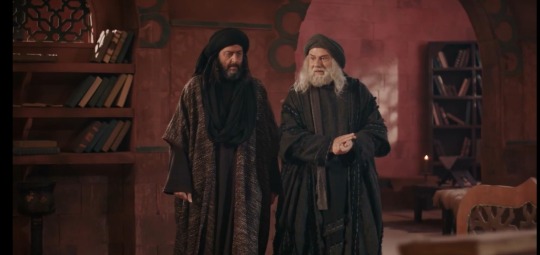

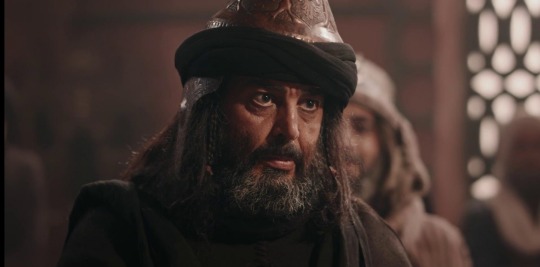


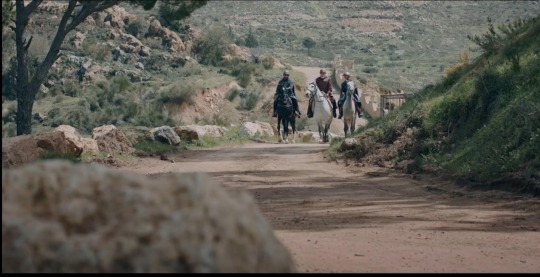

#fath al andalus#period dramas#the conquest of al andalus#series#tariq ibn ziyad#king rodrigo#musa ibn nusayr#conde don Julián#count don julián#julián de ceuta#rey rodrigo#florinda#princess florinda#abu basir#suhail jabei#taiseer edris#rafik ali ahmad#pierre dahger#marah hijaz#akef najem#al andalus#mohammad alenezi#dragan sisa#mohamed rageh#momen ebba#eman alshehabi#nouamane laholu#book scans related
4 notes
·
View notes
Text
First of all, thank you for following the bookscans posts, I hope you're enjoying them. Now I wanted to share some extra facts related to the third part, like the Tudmir Pact and more about Abd al-Aziz and Egilona, so here we go:
• The Tudmir pact
The pact between Teodomiro and Abd al-Aziz was signed on April 5, 713 and its text is:
In the Name of Allah, the Gracious, the Merciful. Edict of 'Abd al-'Aziz ibn Musa ibn Nusair to Tudmir ibn Abdush [Theodomir, son of the Goths]. The latter obtains peace and receives the promise, under the guarantee of God and his prophet, that his situation and that of his people will not be altered; that his subjects will not be killed, nor taken prisoners, nor separated from their wives and children; that they will not be prevented from practicing their religion, and that their churches will not be burned or deprived of the objects of worship that are in them; all this as long as it satisfies the obligations we impose on it. Peace is granted with the delivery of the following cities: Uryula [Orihuela], Baltana, Laqant [Alacant], Mula, Villena, Lurqa [Lorca] and Ello. Furthermore, you must not give refuge to anyone who flees from us or is our enemy; nor cause harm to anyone who flees from us or is our enemy; nor cause harm to anyone who enjoys our amnesty; nor hide any information about our enemies that may come to their knowledge. He and his subjects will pay an annual tribute, each person, of one dinar in cash, four measures of wheat, barley, grape juice and vinegar, two of honey and two of olive oil; for the servants, only a measure. Given in the month of Rajab, year 94 of the Hegira [713]. As witnesses, 'Uthman ibn Abi 'Abda, Habib ibn Abi 'Ubaida, Idris ibn Maisara and Abu l-Qasim al-Mazali.
Various versions of the Pact of Tudmīr are known, all of them are not contemporary and it seems that the pact had an important impact, since there are manuscripts about It writen by some authors throughout the Middle Ages, the oldest by geographer Abu al-Abbás Áhmad ibn Úmar al-Uḏrī (Dalías, Almería, 1003- Almería or Valencia, 1085), those by Abū Ja'far Aḥmad ibn Yaḥyā ibn Aḥmad ibn 'Amirah al-Ḍabbī (Vélez-Rubio or Vélez-Blanco, Almería, 1155/1156- Murcia, 1203), Abu Hamid al-Garnāṭī (Granada, 1256-Cairo, 1344) and Ibn Abd-al-Múnim al-Ḥimyarī (Ceuta, 15th century- ?, 1495).
At the library of the Royal Monastery of San Lorenzo de El Escorial is preserved the manuscript of the al-Ḍabbī version of the pact (well, plus some annotations in Spanish from early 19th century) in his work Bughyat al-multamis fī tārīkh rijāl ahl al-Andalus (Wish fulfilled of the one who investigates, about the history of the men of al-Andalus), which is part of the Arabic manuscripts collection held at El Escorial (in the web you can find 153 digitalized manuscripts), started by Phillip II of Spain during the 16th century.
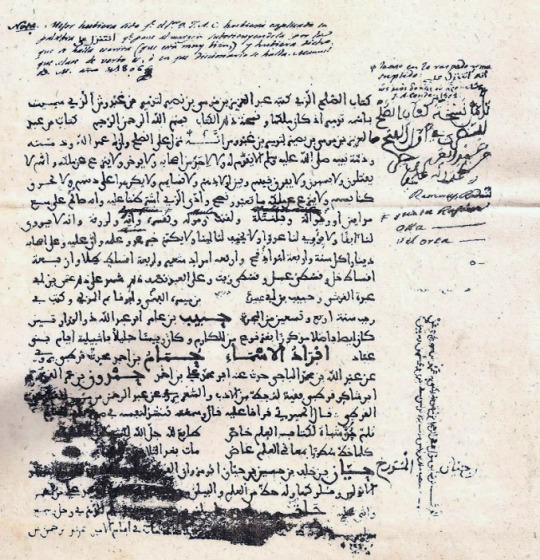
Btw this Arabic manuscript collection is the topic of one of the chapters of the book De Mayrit a Madrid (From Mayrit to Madrid), one of the books that is on the bookscans list, so if you want to know more about this topic, wait for when I share its bookscans.
And for ending with the Tudmir Pact, here's a map showing the cities included in the pact:

• Abd al-Aziz and Egilona
Note: The genealogical links listed below might not be 100% exact, because some data varies depending on the source. Sorry if it's a bit messy, genealogy is complicated (specially if Royal families are involved)
An interesting fact is that some sources point that Abd al-Aziz's mother was Umm bint Marwan ibn al-Hakam, a daughter of Caliph Marwan I, making Abd al-Aziz (born in 685) one of the grandsons of the 4th Umayyad Caliph of Damascus.
During the conquest, Abd al-Aziz and Egilona married in 713. Due to the name Umm'Asim Egilona is sometimes given, it's known that they had a son, although it's not known anything more about him, and they had a daughter too, Aïsha.

After the death of Musa ibn Nusayr in 715, Abd al-Aziz started to mistrust the new Caliph Suleyman, as its possible that the Caliph ordered to murder Musa.
The relationship between the Caliph and Abd al-Aziz was tense, since Abd al-Aziz's title of governor of Al Andalus was given by his father Musa ibn Nusayr, not by the Caliph, so Sulayman was afraid of a possible uprising and Abd al-Aziz turning Al Andalus into an independent territory. As it is possible that Egilona suggested Abd al-Aziz to crown himself and turn away from the caliphate, or at least that were the rumours, and that alleged conspiracy led to Sulayman sending Ziyad ibn Udhara to murder Abd al-Aziz in Seville in 716.
It is not known exactly when Egilona died, although is likely the year of her death is after 718. About their daughter Aïsha bint Abd al-Aziz, she eventually married Fortún ibn Qasi, governor of Zaragoza and the Ebro valley and head of the Banu Qasi, and had two sons Zahir and Musa ibn Fortun, the later married Oneka of Pamplona. They had two sons, Mutarrif and Musa ibn Musa, whom later in the book AL ANDALUS. Historical figures there will be a chapter about (the chapter Musa ben Musa ben Qasi, the third King of Spain). Musa ibn Musa's domains were occasionally independent from the Umayyad emirate of Córdoba since he and his descendants allied with either the emirate or with Christians like the future kingdom of Navarre, whose Royal family had blood ties with the Banu Qasi, some of them being:
- Eneko Aritza, Lord "King" of Pamplona, was Musa ibn Musa's brother, since Eneko was the son Oneka had with her first husband Eneko Semenoitz
- Asona Enekoitz, one of the daughters of Eneko Aritza, niece and wife of Musa ibn Musa. Their children were Lubb ibn Musa, Mutarrif ibn Musa, Fortún ibn Musa and Awriya bint Musa
- Belasquita Garcés of Pamplona, daughter of Eneko Aritza's son, García. She was Musa ibn Musa's daughter-in-law since he married Mutarrif ibn Musa ibn Musa.
- Fortún Garcés, son of Eneko Aritza's son García. Fortun married Awriya bint Lubb ibn Musa, daughter of Lubb ibn Musa and an Arab noblewoman Ayab al-Bilatiyya. Their children were Eneko, Aznar, Belasko, Lope and Oneka.
- Oneka Fortúnez, daughter of Fortún Garcés and Auria/Awriya bint Lubb. Oneka Fortúnez married twice, she firstly wed the Emir Abd Allah I of Córdoba, she was known as Durr (Pearl), their children being Muhammad, Zayd, al-Baha' and Fatima, Muhammad's son was the first Caliph of Córdoba, Abd al-Rahman III; then Oneka married her cousin Aznar Sánchez.
Descendants by MUHAMMAD
- Muhammad, son of Emir Abd Allah I of Córdoba and Oneka Fortúnez, he had Abd al-Rahman III with a Basque woman, Muzna.
- Abd al-Rahman III, 8th Emir and first Caliph of Córdoba. He had several wifes and concubines, and many children, but the one who succeeded him was al-Hakam II, one of the sons he had with one of his wifes, a Christian captive called Maryam.
- Al-Hakam II, 2nd Caliph of Córdoba, son of Abd al-Rahman III and Maryam. Al-Hakam was succeeded by Hisham II, a son he had with the concubine, Subh al-baskunsiyya, a Basque woman named Aurora, but then she took the name Subh.
- Hisham II, 3th Caliph of Córdoba, son of al-Hakam II of Córdoba and Subh. He firstly was overthrown by Muhammad II, and became Caliph again after the second rule of Muhammad ended.
-Muhammad II, 4th Caliph of Córdoba, son of Hisham, who was son of Abd al-Yabbar, one of Abd al-Rahman III's sons. He overthrew Hisham II, but Muhammad II was overthrown by Suleyman al-Mustaín, and Muhammad II started his second rule after he overthrew Suleyman. Muhammad II's sons were Abd al-Rahman IV and Hisham III.
- Suleyman, 5th Caliph of Córdoba, son al- Hakam, who was son of Suleyman, one of Abd al-Rahman III's sons. After Hisham II died, Suleyman's second rule started, but he was defeated and killed by the governor of Ceuta, Alí ibn Hamud al-Násir, who became the 6th Caliph of Córdoba and first Caliph of the Banu Hamud dinasty.
- Abd al-Rahman IV, 7th Caliph of Córdoba, son of Muhammad II. After Ali ibn Hamud was murdered, he was proclaimed Caliph, although it was después with Ali ibn Hamud's brother Al-Qásim, and after Abd al-Rahman IV died, Al-Qásim fully became the 8th Caliph of Córdoba.
- Abd al-Rahman V, 10th Caliph of Córdoba, brother of Muhammad II. After the second rule of Al-Cásim ended, he became Caliph, but he was murdered a year later. He was succeeded by his cousin Muhammad III.
- Muhammad III, 11th Caliph of Córdoba, son of Abd al-Rahman, who was son of Ubayd Al-lah, one of Abd al-Rahman III's sons. He had a daughter with the slave Amin'am, who was Wallada bint al-Mustakfi. Muhammad died, and Ali ibn Hamud's son, Yahya al-Muhtal returned.
- Hisham III, 12th Caliph of Córdoba, son of Muhammad II. He became Caliph when Yahya al-Muhtal was overthrown and his second rule ended. After some years, Hisham III was overthrown during a popular uprising, the Caliphate of Córdoba was abolished, so Hisham was the last Caliph of Córdoba, and the first period of Taifas began.
- Wallada bint al-Mustafki, the only child of Muhammad III, became a famous poetress. Wallada inherited her father's assets when he died and she opened her palace to the education of women from good families to women of low status and even slaves; poets and writers also attended. Among her students, Muhya bint al-Tayyani stands out, a poetress of very humble status. Wallada welcomed her into her palace, and it is said that they were lovers.
It is known that she embroidered her verses on her dresses, being the most well-known: "By Allah, I deserve any greatness/ and I proudly continue my path/ I gladly give my lover my cheek / and I give my kisses to whoever wants them"; and she did not veil on the street. Wallada participate in men's competitions, in one of them she met the poet Ibn Zaydún, with whom she had a passionate love story, as is it shown in several of their poems. Wallada had other lovers like Ibn Abdus, but she never married.
(Mental Note: I have to dedicate a post to Wallada's poetry someday)
Descendants by AZNÁR SANCHEZ
- Toda Aznárez, daughter of Oneka Fortúnez with her second husband Aznar Sánchez. Toda married Sancho I of Pamplona, a distant cousin and first official King of Pamplona. Their children were García I of Pamplona (married Countess Andregoto I of Aragon, their son was Sancho II of Pamplona), Urraca (married Ramiro II of Leon), Oneka (married Alfonso IV of León, their son was Ordoño IV), Sancha (married Ordoño II of León, their son was Sancho I) , Belasquita and Orbita (married al-Tawil, governor of Huesca).
- Sancho II of Pamplona, García I and Andregoto's son, married Urraca Fernández, daughter of Fernán González, Count of Castile. Among their children were García II of Pamplona and Urraca. Urraca married Al-Mansur, hayib of Caliph Hisham II of Córdoba, and she took the name Abda, and was the mother of Abd al-Rahman Sanŷul (or Sanchuelo), who became hayib of Hisham II after his brother ʿAbd al-Málik al-Muẓáffar (son of Al-Mansur and Al-Dalfāʾ) died. Abd al-Rahman Sanchuelo had a son, Abd al-Aziz ibn Ámir, who, after the of the Caliphate was splitted into Taifas, became Emir of the Taifa of Valencia. Abd al-Aziz was succeeded by his son Abd-al-Malik, but Abd-al-Malik was overthrown by Al-Mamún, Emir of the Taifa of Toledo.
- García II of Pamplona was succeeded by his son Sancho II of Pamplona, who married Muniadona of Castile, and they were parents of García III of Pamplona (ancestors of the Kingdom of Navarre) and Ferdinand I of Leon, who married Sancha of Leon, who was the great-great-grandaughter of Ramiro II of Leon (ancestors of the Crown of Castile and the Kingdom of Portugal, via their son Alfonso VI of Leon). Plus Sancho II of Pamplona had a son out of wedlock, Ramiro I of Aragon (ancestors of the Crown of Aragon)
#al andalus#historyblr#pact of tudmir#al andalus. historical figures#al andalus. personajes históricos#abd al-aziz ibn musa#abd al-aziz#teodomiro#tudmir#spanish history#al andalus history#book scans related#book scans#bookblr#egilona#ailo#queen egilona#umm'asim
5 notes
·
View notes
Text
Tariq Ibn Ziyad
Tariq Ibn Ziyad led the main assault against Spain to capture it from the kuffar along with Musa Ibn Nusair. Tariq Ibn Ziyad was sent by Musa to explore Spain before its conquest and he did that and captured Gibraltar (Jabl Tariq or Mount of Tariq). He did this with 400 men and continued to capture small bits of land in Spain then eventually gave the red light for the main invasion. Tariq was a berber and was born in 689. Tariq conquered much of Spain for the Muslims and often did this with few men. Tariq's army killed the Visigoth king Roderic, destroying the visigoths and leaving only a few rebels. Tariq Ibn Ziyad died naturally in 720 like many other prominent mujahids His most famous battle was:
Battle of Guadalete
This is the battle were the few Muslims army fought the 100,000 strong Christians and this is the battle where their King Roderic died.
He also conquered Toledo and Cordoba, two cities of Visigoth power.
0 notes